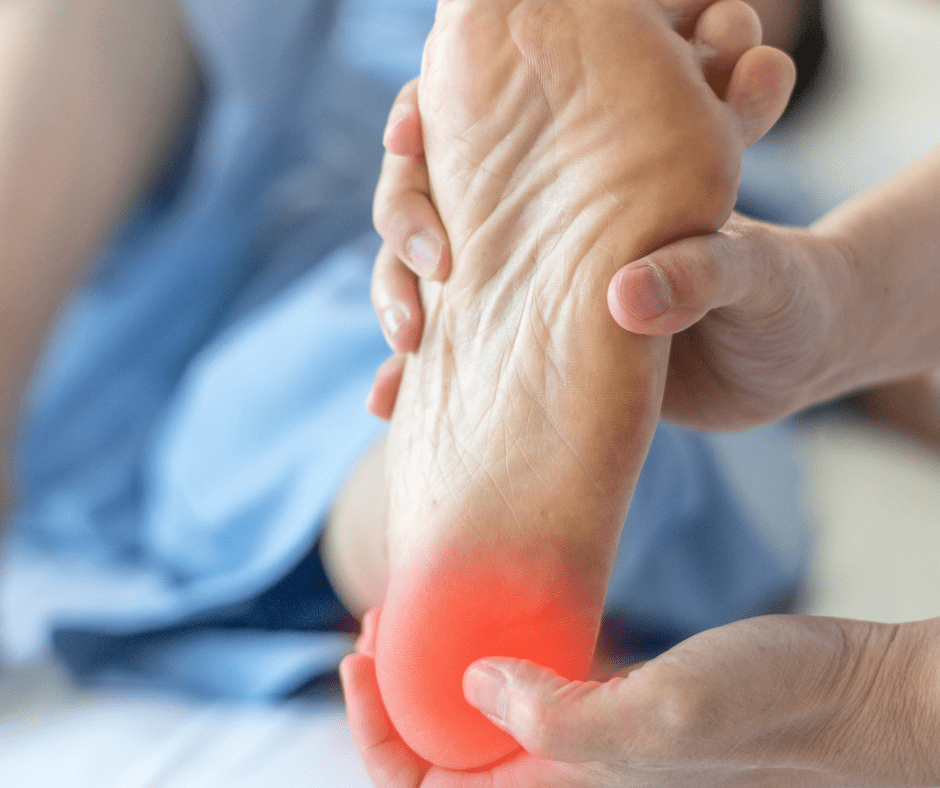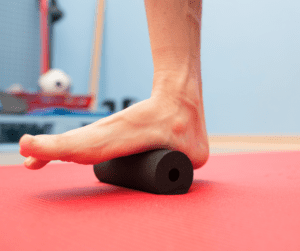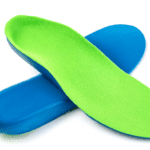Plantar fasciitis can be extremely debilitating for a runner!
I mean… nothing can disrupt normal daily living or your exercise routine quite as much as a pain that keeps you from literally moving around…
Known as one of the most common orthopedic complaints… Plantar fasciitis causes pain in the bottom of your heel or on other parts underneath your feet. The plantar fascia is a thick, weblike ligament that connects your heel to the front of your foot. It acts as a shock absorber and supports the arch of your foot to help you run and walk.
Let’s have a look at how you can treat an inflamed plantar fascia and prevent painful feet when running, as well as exercises that you can do at home that will help you heal and prevent plantar fasciitis.

Symptoms Of Plantar Fasciitis
The main symptom of plantar fasciitis is pain at the bottom of your heel or sometimes at the bottom midfoot area. It usually affects just one foot, but it can affect both of your feet.
Symptoms also include pain that is worse in the morning or when you stand after sitting for a long time or a swollen heel.
What Causes Plantar Fasciitis?
Like with most injuries, it’s very seldom that there is one specific cause of that injury…
A few known causes of Plantar Fasciitis include:
– Running shoes that have run their course & don’t provide enough support.
– Running long distances on beach sand.
– Tightness in calf muscles (soleus).
– Being overweight is a risk factor.
– Extreme inflexibility in the plantar fascia.
– Tight Achilles’ tendons and structural abnormalities, like having flat feet.
So… What do we do once we have it?

How Do You Fix Plantar Fasciitis?
We recommend rolling your plantar fasciitis gently with ice, you could freeze a bottle of water and just gently roll that on the bottom of your foot – where the pain is. You could then use a golf/cricket ball and actually massage under your feet.
Strengthening exercises will also help with plantar fasciitis.
Put a towel underneath your feet on a tiled floor. Then use your toes to pull that towel and scrunch it up under your feet. So you’re almost doing “bicep curls” with your toes to strengthen your plantar fascia.

If the pain doesn’t improve after doing these things, you should make an appointment with a sports doctor – to ensure it isn’t more serious than you might think.
How to Treat & Prevent Plantar Fasciitis in Runners (Plus Exercises To Do At Home For Pain Relief)
Being runners ourselves… We understand how difficult it is to take a break…
Does Running With Plantar Fasciitis Make It Worse?
YES! Running with plantar fasciitis will make it worse.
If you continue to run with plantar fasciitis, you will cause additional damage to the plantar fasciitis ligament, worsening the condition and causing more pain that could make even walking difficult.
As we always say…. REST is a four-letter word no runners want to hear….
How To Keep Up Your Training When You Have Plantar Fasciitis?
Stop!
This really depends on where on the foot it’s sore and whether it’s getting worse or not while you are exercising.

If it’s getting worse, then don’t carry on with your training, otherwise, it’s going to get worse and worse until you can’t run even if you wanted to.
Cross-training is advisable, like stationary cycling, or perhaps some work on the elliptical, or even swimming. These are things you can do to maintain your fitness.
Note: It is possible to figure out what is causing the pain. It could even be a lack of support in your shoes…
Make Plantar Fasciitis Disappear For Good!
As we mentioned above, the pain could be coming from your shoes or there could even be a problem with actual weakness in the underside of your foot.
A little muscle, the fascia that connects your heel to your toes, is responsible for curling your toes.
To strengthen that, do the towel method as we said above but also get your shoes checked out, the shoes may also be allowing a little bit too much play.
They could also be a little bit hard, in which case your foot is going to be sliding too much across the top of the shoe. Because the foot is not able to settle into the shoe nicely.
Orthotic Inserts To Help With Plantar Fasciitis

Supporting your arch with orthotics is a good way to protect your plantar fascia while it heals.
I wouldn’t use orthotic inserts as a preventative measure but they could certainly help with the healing process.
Let’s have a look at an ultimate plantar fasciitis checklist...
Checklist For Sorting Out Plantar Fasciitis
- Make sure you are in the correct shoes.
- Strength exercises.
- Tennis Ball Roll
Place a tennis ball, rolling pin, frozen water bottle, or other cylindrical objects under your foot and gently roll.
- Towel Stretch
As explained earlier.
In a seated position, push your leg out so that just your heel is on the floor. Bend down and grab your big toe, bending it backward (Gently). Flex your ankle.
- Calf Stretch
Stand facing a wall or something to lean onto, with one foot in front of the other (the back foot is the one with plantar fasciitis). Keeping the back leg straight, lean your weight forward, bending into the front knee. (Make sure your back heel stays on the ground).
- If 1 & 2 don’t help then visit a Podiatrist.
- Take anti-inflammatories such as Ibuprofen to help reduce pain and swelling.
- Regular icing to help reduce pain and swelling.
- Stretching of the calf muscles, and when less painful introduce stretching of the plantar fascia.
- Reduce training volume and include cross-training.
Here at Coach Parry, we’re massive advocates of strength training. We’ve put together this free strength training plan for runners that you can do once a week, at home and with no expensive equipment needed. You can access it by clicking here.




Comments are closed.